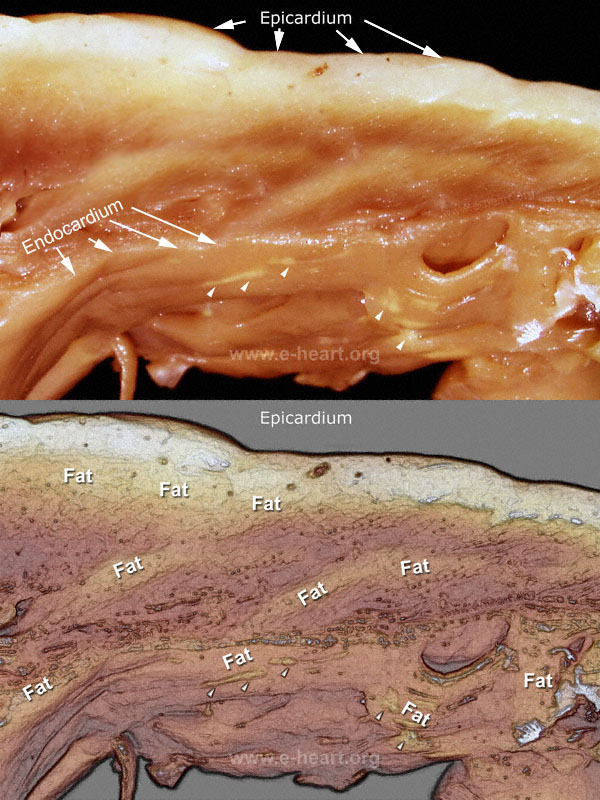Arrhythmogenic Right Ventricular Dysplasia / Cardiomyopathy - ARVD / C
 Section of the right ventricular free wall shows fatty infiltration seen as yellow areas alternating with the normal red-brown color of the myocardium. Yellow streaks (arrowheads) on the endocardial surface due to adipose tissue deposition are also present. The lower image is an illustration highlighting the areas of adipose tissue in the myocardium. Pathologic examination of the heart with suspected ARVD should be very thorough, since there is a wide variation of the normal amount of adipose tissue infiltration in humans.
Section of the right ventricular free wall shows fatty infiltration seen as yellow areas alternating with the normal red-brown color of the myocardium. Yellow streaks (arrowheads) on the endocardial surface due to adipose tissue deposition are also present. The lower image is an illustration highlighting the areas of adipose tissue in the myocardium. Pathologic examination of the heart with suspected ARVD should be very thorough, since there is a wide variation of the normal amount of adipose tissue infiltration in humans.
(Tansey DK, Aly Z, Sheppard MN : Fat in the right ventricle of the normal heart.
Histopathology. 2005 ;46: 98-104.)
This web site is organized by topics centered around the morphologic features that define the diseases of the heart and blood vessels. In some instances the morphology needs to be correlated with clinical, physiologic or genetic information to ascertain the diagnosis. Extensive illustration of cardiovascular pathology entities is presented throughout the site in the form of photographs, illustrations and 3d models and animations. References to peer reviewed literature, textbooks on the subject and useful links to web sites are used.
Cardiomyopathy and genetic diseases.
The pathology of the cardiovascular system includes diseases that primarily
affect the heart muscle cells (also called myocytes) and are generally
known as cardiomyopathies. According to the World Health Organization
(1) The cardiomyopathies can be acquired (infectious, toxic, autoimmune,
iatrogenic) or have a genetic basis. From
the morphologic standpoint the have been classified into four main categories,
dilated cardiomyopathy (DCM), hypertrophic (HCM), restrictive (RCM) and
arrhythmogenic right ventricular dysplasia/cardiomyopathy (ARVD / ARVC). However
a trend to classify them on the basis of their genetic causes exists and
is the basis for a new proposal (2).
Congenital malformations and acquired diseases of the heart and vascular system
Genetic defects have been described in each one the 4 morphologic
types of cardiomyopathy. Congenital malformations have also been
associated with genetic alterations, but in many instances there is no
specific mutation or chromosomal alterations found. Genetic diseases
can also affect the vessels either as intrinsic structural problems in
the vessel wall (in vessels such as the aorta) or by altering the metabolism
of the vessel (like in atherosclerosis).
In other instances the pathogy of the heart and vessels is modified by therapeutic procedures (angioplasty) or devices (stents, balloon pumps, prosthetic valves, prosthetic vessels / conduits and ventricular assist devices (also known as artificial hearts))


 Section of the right ventricular free wall shows fatty infiltration seen as yellow areas alternating with the normal red-brown color of the myocardium. Yellow streaks (arrowheads) on the endocardial surface due to adipose tissue deposition are also present. The lower image is an illustration highlighting the areas of adipose tissue in the myocardium. Pathologic examination of the heart with suspected ARVD should be very thorough, since there is a wide variation of the normal amount of adipose tissue infiltration in humans.
Section of the right ventricular free wall shows fatty infiltration seen as yellow areas alternating with the normal red-brown color of the myocardium. Yellow streaks (arrowheads) on the endocardial surface due to adipose tissue deposition are also present. The lower image is an illustration highlighting the areas of adipose tissue in the myocardium. Pathologic examination of the heart with suspected ARVD should be very thorough, since there is a wide variation of the normal amount of adipose tissue infiltration in humans.